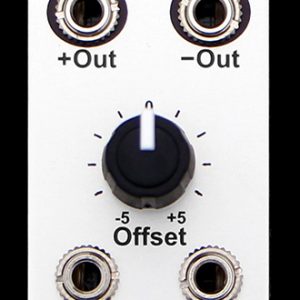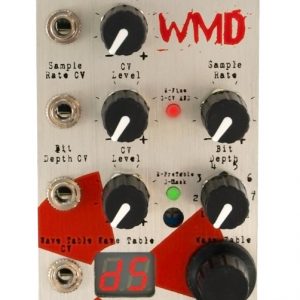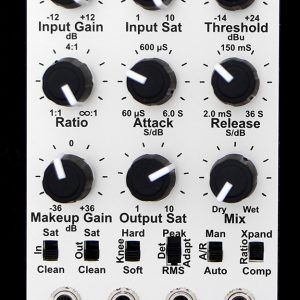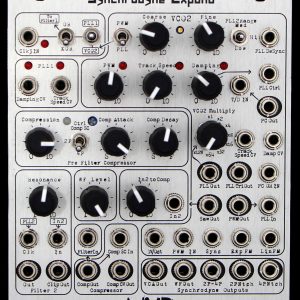Description
The WMD Multimode Envelope is our take on the classic ADSR. It offers expanded controls, multiple logic modes, and voltage control with the expansion module. This is the most powerful envelope ever designed for eurorack.
Theory of Operation
The Multimode Envelope uses an analog integrator core with digital control over positive and negative slopes. This allows for total control over the envelope shape and logic operation. Since the core is analog, the envelope is smooth and stepless, especially important for slow envelopes.
The nature of the core allows for control over its shape through a feedback mechanism, this design also allows for Voltage Control over each segment and for the entire envelope duration.
The 8 HP Multimode Envelope is small and powerful, easy to integrate into any system that needs a powerful envelope generator. Voltage control was left off so that this envelope can be easily fit into an existing modular system. Add voltage control if desired with the 6HP expansion module.
The Controls
Attack Rate – Determines the speed of the attack. At its lowest (CCW) setting, the attack will be around four minutes. Fastest (CW) is 200µS.
Attack Shape – This affects the rate of attack as the envelope opens. Continuously variable from logarithmic (starts fast and slows) to linear to exponential (starts slowly and speeds up).
Decay Rate – Determines the speed that the envelope will decay down to the sustain level. This has the same time range as Attack and Release.
Decay Shape – This control determines the shape of the decay until the sustain level.
Sustain Level- This controls the breakpoint for the decay segment. When this level is reached (0 t 8 volts), the Envelope will transition from decaying to the mode determined by the Mode knob.
Mode – This knob controls the operation of the Multimode Envelope. Modes are listed below. Turn the knob to the desired mode.
Release Rate – Determines the speed of the release segment. The release segment is from the sustain level down to 0 volts.
Release Shape – This control determines the shape of the release until the 0 volts is reached.
Gate/Trig – This input starts the envelope. How it is handled is dependent on the active mode. When a gate is present, the Gate LED will be lit.
0-8V Out – This is the normal envelope output, it produces voltage from 0 to 8 volts.
+-8V Out / -+8V Out These outputs give full swing envelopes of 16 Volts peak to peak. The -+8V Out is inverted.
Manual – This button allows for manual triggering or gating of the envelope.
Modes of Operation
First, a note about gates and triggers. A gate is an on or off signal that has duration. A trigger is an on or off signal whose duration is ignored.
When the gate turns on, the envelope will run through the specified segments until the gate is released. If the gate goes off at any time, the envelope will immediately jump to the release segment. Gate modes have the ability to sustain, and are applicable to ADSR and ADSAR.
Trigger modes will cause the envelope to run its course every time it is triggered, from start to finish, regardless of the trigger’s length. Trigger modes include AR, ADR, and ADAR.
ADSR – This is the classic East Coast envelope shape. Upon a Gate input (key down), the envelope opens, then closes to the sustain level. When the gate is off (key up), the envelope releases to ground. To use as an ASR envelope, turn the Sustain fully CW and Decay will be ignored.
AR – This is the classic West Coast envelope shape. Upon a trigger input, the envelope opens with the Attack control, peaks, and then falls with the release control. It is triggered instead of gated and will not sustain.
ADR – The ADR is a trigger mode that will not sustain. Instead, at the sustain point, Decay transitions instantly to Release, allowing you to change shapes or speeds in the middle of the falling action.
ADSAR – This gate mode attacks, decays and sustains like a normal ADSR. After the gate is released (key up), the envelope will attack again and then release. This gives you an accent on key up.
ADAR – This trigger mode attacks, then decays until reaching the sustain level, then attacks again and releases.
ADSRst – ADSR Step Through mode runs one segment at a time as triggered. This mode causes sustain after each segment runs. After attack, it will sustain at 8 volts. After decay it will hold at the sustain level. After release, the cycle is finished and 0 volts will be output. Each segment must be complete before another trigger is recognized. This mode requires three triggers per cycle.
ADSARst – This is similar to ADSRst, but with a second attack after the decay. This mode requires four triggers per cycle.
ADRcy – This mode will cycle automatically after release is compete. It can be an AR cycling envelope by setting the sustain level to maximum. Decay will transition to Release at the sustain point. A trigger or gate will reset to the attack segment.
ADARcy – This self cycling mode works just like ADRcy, but will attack again from the sustain point after the decay segment. A trigger or gate will reset to the attack segment.
Specification:-
- Computer Controlled Circuitry
- Analog Envelope Generation
- Segment Time: 200µS to 4 minutes
- Variable Segment Shape/Curve
- Doepfer Standard 0-8 Volt Output
- Gate & Envelope Strength LEDs
- Multiple Modes of Operation
- Full Swing Output
- Inverted Full Swing Output
- Manual Gate Button
- Current Consumption: -12V: -27mA; +12: +49mA
- Panel size: 8HP






